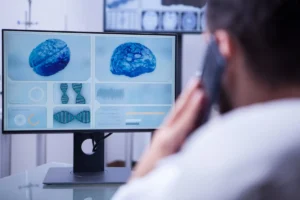Ilse Andrea Carranza Ramírez, teacher and clinical psychologist specialized in child and adolescent psychotherapy, neuropsychology and ASD, offers us in this article her knowledge about the diagnosis of autism spectrum disorder (ASD) and attention-deficit/hyperactivity disorder (ADHD).
Autism spectrum disorder (ASD)
Autism spectrum disorder (ASD) is a neurodevelopmental condition that affects individuals from an early age, manifesting differently in each person. Characterized by difficulties in social interaction, repetitive behavior patterns, and restricted interests, ASD has a high frequency of co-occurring medical conditions, according to the definition proposed by the Instituto de Autismo Domus in 2018.
Diagnosing ASD is based on specific criteria, such as those established in the DSM-5. This manual provides a clear, evidence-based guide to identify the distinctive features of autism, which facilitates an appropriate approach to treatment and support. Some of these features include social difficulties, restricted interests and repetitive behaviors, communication problems, and sensory sensitivities.
- Social difficulties: they may have difficulty relating to others, struggle to interpret social cues, and find it hard to make friends or maintain close relationships.
- Restricted interests and repetitive behaviors: they may have restricted interests and repetitive behaviors that provide them with a sense of comfort and security.
- Communication problems: they may have trouble understanding the nuances of nonverbal language, such as tone, volume, and inflection. They may also have difficulty initiating and maintaining a conversation.
- Sensory sensitivities: they may be hypersensitive or hyposensitive to sensory stimuli such as light, sound, touch, and smell.
Who diagnoses ASD?
This is a question many parents ask, as well as some adults who consider that they may need an evaluation on this matter. The diagnosis of ASD requires the involvement of professionals in mental health and development with specific experience and training. Usually, the treating physician, such as a pediatrician, is the first to detect it.
This professional typically refers the patient to other health specialists for more detailed assessments. These may include neuropsychologists and clinical psychologists to administer standardized tests, as well as direct observations of the patient.
In addition, an occupational therapist may be requested to determine the patient’s sensory profile. The multidisciplinary assessment may also involve collaboration with other specialists in autism, such as communication therapists and speech-language pathologists. The multidisciplinary and transdisciplinary approach ensures a comprehensive evaluation that provides detailed information not only to confirm or rule out ASD, but also to design an intervention plan and understand the individual’s specific needs to ensure optimal care.

Subscribe
to our
Newsletter
How is ASD evaluated?
The evaluation of ASD involves several methods, including the use of tools such as the ADOS-2 (Autism Diagnostic Observation Schedule, Second Edition) and the ADI-R (Autism Diagnostic Interview-Revised), tests to assess the child’s development, as well as complementary tests to estimate intellectual quotient (either with specific standardized tests, or through developmental instruments that provide this information).
These tests may be administered by psychologists, neuropsychologists, or educators who are certified and trained for their correct administration and evaluation. Typically, these certifications and trainings are obtained at centers specialized in ASD, which are specifically dedicated to providing this training to professionals.
This thorough, evidence-based assessment provides a complete understanding of the individual’s strengths and needs, allowing for specific recommendations and strategies to support their development and emotional well-being. Additionally, it helps families and professionals make informed decisions about the treatment, education, and support required for the individual.
ASD symptoms in boys and girls are usually detected in the early stages of development. However, some children with apparently typical functioning may go unnoticed until adolescence or adulthood, when social demands increase and their difficulties become more evident. Therefore, diagnosing ASD in adolescents and adults is also important.
Usually, the evaluation of these profiles is carried out through comprehensive case conferences and using some of the tools mentioned above. Although the assessment method remains the same, the format and adjustments are adapted so that the proposed activities are aimed at adolescent and adult populations.
Attention-deficit/hyperactivity disorder (ADHD)
The attention-deficit/hyperactivity disorder (ADHD) is a neurobiological developmental disorder that affects a person’s ability to sustain attention, control impulses, and regulate behavior appropriately for their age and environment. It is characterized by symptoms of inattention, hyperactivity, and impulsivity; they may also be very restless, talk a lot, act without thinking, or have trouble waiting their turn.
These symptoms can manifest differently in each individual and be detected in childhood or in adulthood. ADHD can affect people of all ages and can have a significant impact on daily life, including academic performance, interpersonal relationships, and work functioning. Treatment for ADHD usually includes a combination of cognitive-behavioral therapy, neuropsychological rehabilitation, educational support, and, in some cases, medication.
Diagnosis and treatment of ADHD
This process is usually conducted by mental health professionals such as psychiatrists, psychologists, neuropsychologists, and pediatricians. These experts evaluate symptoms comprehensively and design a personalized treatment plan for each individual; the evaluation is comprehensive and multidisciplinary. The role of the clinical psychologist or neuropsychologist is to administer a series of psychological tests to understand the individual’s cognitive functioning, whether a child or an adult.
Based on the results of these tests, an intervention plan is proposed to address the symptoms. The evaluation can be shared with the treating physician (neurologist, psychiatrist, or pediatrician) to consider the need for medication. However, the decision to prescribe medication rests solely with the treating physician, based on the comprehensive evaluations carried out in collaboration with the multidisciplinary team of professionals.
Attention-deficit/hyperactivity disorder (ADHD) is not exclusive to childhood; it also affects adults, although it may manifest differently. In adults, ADHD symptoms can range from chronic distractibility to difficulty completing tasks, procrastination, and a tendency to make impulsive decisions. Some adults with ADHD face significant challenges in maintaining job and financial stability, as well as in establishing and maintaining healthy personal relationships.
It is important to recognize that ADHD is not simply a problem of lack of attention or hyperactivity, but a complex neuropsychiatric disorder that can have a profound impact on quality of life. Appropriate diagnosis and treatment will be necessary for symptom improvement.
Both neurodevelopmental disorders involve multidisciplinary treatment, where, in general, the goal is for the treatment to impact the quality of life of both the person affected and their family.
Bibliography
- Vaillard, J, Reza, D (2018) The ABC of Autism, Domus Ediciones, México.
- American Psychiatric Association. (2013). Diagnostic and statistical manual of mental disorders (5th ed.).
If you liked this article about the diagnosis of autism spectrum disorder (ASD) and attention-deficit/hyperactivity disorder (ADHD), you will surely be interested in these NeuronUP articles:
“This article has been translated. Link to the original article in Spanish:”
Neurodesarrollo: entendiendo el diagnóstico del trastorno del espectro autista (TEA) y trastorno por déficit de atención e hiperactividad (TDAH)







 Inhibition Game for Adults: Categories Against the Clock
Inhibition Game for Adults: Categories Against the Clock
Leave a Reply